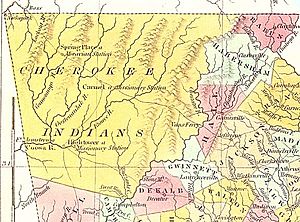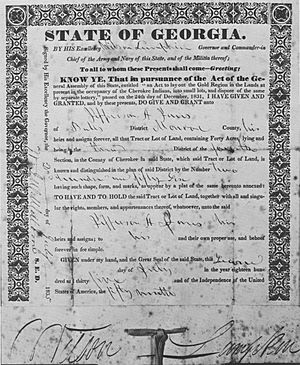Georgia Land Lotteries facts for kids

The Georgia land lotteries were a system used in Georgia in the early 1800s. This system allowed white male citizens to sign up for a chance to win plots of land. These lands had been taken from the Muscogee and Cherokee Nation. Georgia used these lotteries between 1805 and 1833. The goal was to make the state stronger and increase its population. This would give Georgia more power in the U.S. government. While other states also used land lotteries, none were as big as Georgia's.
Contents
How the Land Lotteries Worked
Before 1803, Georgia gave out land using a "headright system." This system was supposed to prevent cheating. However, it actually led to a lot of corruption. A big scandal called the Yazoo land scandal happened because of this system.
Because of these problems, Georgia decided to change how it gave out land. In May 1803, Governor John Milledge introduced the lottery system. The first land lottery happened in 1805. For each person who wanted to enter, a ticket was put into a barrel or wheel. More tickets were added if too many people signed up.
Different Sizes of Land Lots
The land plots given away in the lotteries came in different sizes. The size depended on how good the land was thought to be.
- In 1805, land lots were 202.5 acres (0.8 km2) and 490 acres (2.0 km2).
- In 1807, land lots were 202.5 acres (0.8 km2).
- In 1820, land lots were 250 acres (1.0 km2) and 490 acres (2.0 km2).
- In 1821, land lots were 202.5 acres (0.8 km2).
- In the 1832 Land Lottery, plots were 160 acres (0.6 km2).
- In the 1832 Gold Lottery, plots were 40 acres (0.2 km2).
Who Could Enter the Lotteries?
The rules for entering the lotteries stayed mostly the same for 28 years. People had to pay a small fee if they won a ticket. This fee usually only covered the cost of running the lottery. The state itself did not make money directly from giving away these lands. Some smaller land pieces or lands near big rivers were not part of the lottery. These were sold by the state at public auctions.
Forced Removal of Native American Peoples
The land given away in these lotteries originally belonged to the Muscogee and Cherokee peoples. As Georgia expanded, these Native American groups were forced to give up their ancestral lands.
The Cherokee Fight for Their Land
Some Cherokee leaders, like John Ross and Major Ridge, tried to keep their lands. They took their fight against Georgia to the Supreme Court of the United States. Two important cases were heard: Cherokee Nation v. Georgia (1831) and Worcester v. Georgia (1832).
At first, the Supreme Court ruled against the Cherokee Nation. But later, in Worcester v. Georgia, the Court said the Cherokee Nation was a sovereign (independent) nation. This ruling meant that Georgia's laws did not apply to the Cherokee lands. It also made the Indian Removal Act invalid.
However, U.S. President Andrew Jackson and the State of Georgia chose to ignore the Supreme Court's decision. This was against the U.S. Constitution. Georgia continued to survey and divide the Cherokee lands. This led to the final "1832 Land and Gold Lotteries."
President Jackson used the U.S. Army to force the Cherokee people to leave their homes. This event is known as the "Trail of Tears." Many historians today see this as an act of ethnic cleansing or genocide. A soldier who was part of the removal later said that it was "the cruelest work I ever knew."
The 1831 Governor Election
In October 1831, Georgia voters had to choose between two governors. Governor George Rockingham Gilmer wanted to keep the Cherokee land for the state. This land had several gold mines. He hoped to use the gold to pay for state projects and lower taxes. Wilson Lumpkin, on the other hand, strongly supported giving away the lands. He won the election. This led to Georgia's last three land lotteries.
List of Georgia Land Lotteries
- 1805 Land Lottery — This lottery included Muscogee lands west of the Oconee River. It also included a small area in the southeast of the state. These lands were in Baldwin, Wayne, and Wilkinson counties.
- 1807 Land Lottery — This lottery added more Muscogee lands in Baldwin and Wilkinson counties.
- 1820 Land Lottery — After the Creek War (1813–1814), President Jackson demanded a huge area of land from the Muscogee. This land became the southern third of Georgia. Another smaller area in northeast Georgia was also included. This land was in Appling, Early, Gwinnett, Habersham, Hall, Irwin, Rabun, and Walton counties.
- 1821 Land Lottery — This lottery involved more Muscogee lands, including the future site of Atlanta. Land was taken in Dooly, Fayette, Henry, Houston, and Monroe counties.
- 1827 Land Lottery — This lottery marked the end of the Muscogee presence in Georgia. Land was taken in Carroll, Coweta, Lee, Muscogee, and Troup counties.
- 1832 Land Lottery — This lottery, along with the 1832 Gold Lottery, gave the Cherokee Nation's land to Georgia settlers. This event helped cause the "Trail of Tears." Land was taken in Cass (later renamed Bartow), Cherokee, Cobb, Floyd, Forsyth, Gilmer, Lumpkin, Murray, Paulding, and Union counties.
- 1832 Gold Lottery — By the time of this lottery, the Georgia Gold Rush was already slowing down. The state did not promise that gold would be found on the lots given away.
- 1833 Fractions Lottery — Georgia held one last land lottery in December 1833. This lottery gave away smaller pieces of land from the Cherokee territory and other lots that had not been chosen in earlier lotteries.



